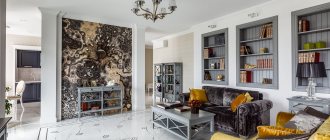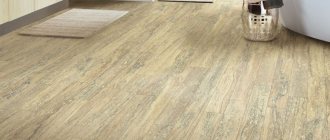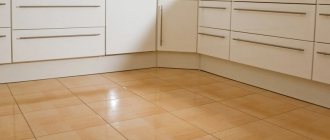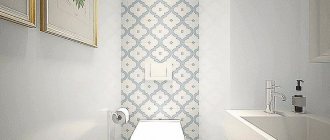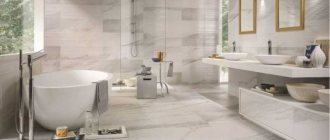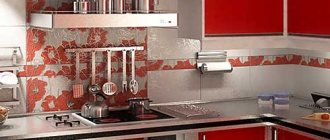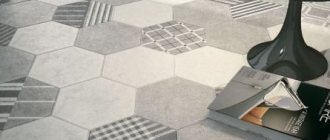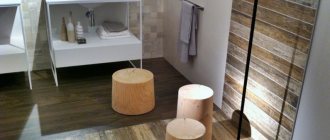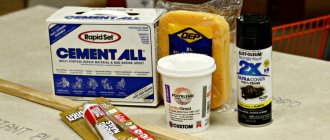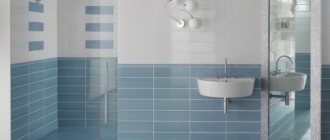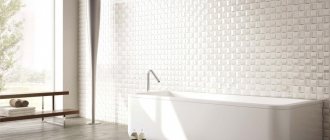Metlach is a decorative technique that can add artistry to the interior, become a spectacular accent of the room, not only aesthetic, but also a completely practical solution for outdoor areas. We learned from the founder of the Faktura studio, designer Ekaterina Lovyagina, in which interiors and in combination with what materials Metlakh tiles will reveal themselves in all their glory, and why they are not suitable for everyone.
Mettlah differs from other types of ceramic tiles in that it is colored before firing: natural pigment is added to the mixture, then it is shaped and sent to the kiln. As a result, the color turns out more natural, “honest”. The design is applied to the tile in two ways: either by a method reminiscent of cloisonne enamel (the form is immersed in a die and another pigment is poured into it), or by a more accessible technique like silk-screen printing.
The video below shows how a French factory produces brooms.
Typically, the shapes of the broom are geometrically simple and regular - multi-format squares, rectangles, triangles, hexagons and octagons, crosses, “candies” (in addition, the palette includes details for decorating steps, baseboards, sides and corners). When joining tiles of different shapes and different colors, stacked carpets are obtained. The number of possible patterns can hardly be counted.
3 facts about Metlakh tiles
Thanks to firing at high temperatures (at least 1200 °C), brooms are highly durable. It is resistant to moisture, natural acids, high and low temperatures. Therefore, the material can be safely used in residential and public buildings, as well as outdoors.
Tile sizes vary from 3.5 to 20 cm (length of one side). The smallest element is a triangle 3.5x3.5x5 cm, the largest is a square 20x20 cm.
The color of the broom is determined by natural pigments that are added to the clay mass. In the 2020 catalog of the French brand Winckelmans, the main palette includes 16 colors. Plus, the collection contains several patterns.
We asked designer Ekaterina Lovyagina from, who uses this material in almost every project, to talk about the features of using Metlakh tiles in the interior.
The material is not for everyone
Metlakh tiles are not suitable for everyone. It is a rather bold decorative technique that allows you to achieve the so-called wow effect and add artistry to the interior. To live in an interior with ornaments, you need to have mature taste. This is the choice of an educated, accomplished person who understands how the material will manifest itself in the space of the house, because he has already seen similar solutions while traveling.
Interior of a private country house. Project by Svetlana Galfayan and Marina Volkova
For what interiors?
The use of Metlakh tiles is acceptable wherever we like to see some kind of geometry. This can be a modern interior with graphic patterns (zigzags, Christmas tree, squares), or historical European classics with English carpets, medieval castle ornaments. With brooms it’s great to create oriental interiors - in general, any ethnic style. Unless we are unlikely to use it in completely minimalist interiors, although even in this case you can take gray tiles and lay them on the wall - it will turn out beautifully and delicately.
Today, Metlakh tiles are a decorative accent; they do not create any tense atmosphere around them. On the contrary, if we strive to somehow express a room, we decorate it with a pattern. And if we want to move a person’s gaze from the floor to the walls, then we can make the central plane - the floor - dark and empty, and go out to the elegant ones through a frieze and plinth made of broom.
In which areas is it best to use?
Metlach is also ideal for the bathroom, as it does not absorb moisture and does not slip.
In my decorating practice I love and often make beautiful rich carpets, mainly for spacious halls, living rooms, and large kitchens.
A non-standard move would be to use tiles in the corridor as a decorative panel covering the entire wall.
Apartment in Paris, designed by architect and decorator Alirez Razavi
Due to their high strength and wear resistance, brooms are perfect for decorating kitchen aprons and work surfaces.
Metlach is suitable for outdoor terraces, as it withstands rain and dirt, snow and frost.
The broom has special rounded elements on the steps, which allow you to create very beautiful stairs. In my projects I regularly create decorative risers from broomstick.
Metlakh tiles are suitable as exterior cladding for fireplaces. And if it’s a potbelly stove that lags behind the wall, then with the help of a broom you can create an apron-heat breaker behind the fireplace and lay out an area in front of the fireplace.
We can make baseboards out of broom – no problem. If a person has ordinary doorways, but wants to achieve decorativeness, you can put a mosaic strip of broom around the perimeter of the door frame.
What materials can it be combined with?
Brooms interact best with natural materials - stone, wood, including thin parquet. In one house, I joined three trees in the hall - from the living room, the kitchen and the staircase, and in the middle I placed a beautiful broom carpet, above which I hung a lamp. It is closed on all sides except the bottom - the lamp effectively illuminates only the carpet.
Interior of a private house in Krasnodar. Project by Ekaterina Lovyagina
Which brand of broom should I use?
Today there are few traditional factories for the production of metlakh tiles left. One of these factories is Winckelmans in France, operating since 1894. Its official representative in Russia is. We have been working with them for more than 10 years. When a client comes to us, we first show him a large book of patterns from Greta Wolf. This is a kind of rubricator, which presents the key patterns characteristic of each style. Then, based on these graphic schemes, we put together a color scheme. You can view some samples of Metlakh tiles available in the Faktura studio here.
Metlakh tiles are intended for decorative decoration of floors or walls. Such tiles were produced back in ancient times. We’ll talk about it today.
Thanks to its excellent performance, today it is also used in some enterprises of the country. For a long time, Metlakh tiles have not lost any of their popularity.
Nowadays, not only apartments and houses are decorated with it, but also painted carpets are made in museums and other important institutions.
This video will tell you about the pros and cons, as well as the use of Metlakh tiles:
Advantages and disadvantages
Why is this product so in demand? The secret lies in its positive qualities. So, Metlakh tiles:
- Universal
. Tiles are used everywhere: indoors, on buildings, for... Fresh air and precipitation will not harm the metlakh coating. Multiple options for shapes and colors of tiles allow you to create original and never-before-seen designs. - Natural
. The composition of the tiles includes water and natural high-strength. - Durable
. Thanks to special technology, Metlakh tiles are very hard. Even the heaviest object falling will not be able to damage it. It turns out that the heaviest loads are not terrible for the Metlakh carpet. - Durable
. The initially laid coating will retain its appearance and color for a very long time. This property is achieved through deep impregnation with color pigments. With their help, after firing, the product turns into a single whole that is not capable of losing its qualities. - Multitasking
. The tiles are good for both interior and exterior decoration. Metlakh tiles will help you create various and bold patterns on the surface. - Hardy
. The tiles are well suited for exterior decoration. Snow, hail, rain, and wind are not scary for her. If we take others for comparison, then Metlakh tiles resist acid and alkali best of all. - Reliable
. Metlakh tiles are reliable in terms of operation. It can be easily used in rooms with a large concentration of devices and people. - Availability. The building material is accessible to absolutely all segments of the population in terms of price.
This, in every sense positive coverage, has several disadvantages:
- Difficulty in installation. It will be problematic for an ordinary person to create an interesting design pattern from such tiles.
- Difficult to cut with a tile cutter.
- Old fashioned style. Many people don’t like the antique look of the tiles.
Metlakh tiles in the interiors of different rooms (photo)
Bar Bath Living Room Kitchen Hallway Hall
Kinds
Metlakh tiles have several types, which depend on the production method.
- First type: tiles obtained by casting
. This tile has a significant drawback: the resulting products have different thicknesses, as a result, when laying the coating, the lion's share of the products is sent to waste. It's all about production technology. The raw materials are poured into special molds, then dried and sent to the kiln for firing. - Second type: tiles obtained by pressing
. The products are made from powdered clay, water (no more than 6%) and special additives. During the manufacturing process, the mixture is pressed under pressure and then cut into shapes of the required size. Pressed tiles have a porous structure. These tiles are often used for flooring. - Third type: tiles produced by extrusion
. This is the best type of tile. It is obtained using a mouthpiece through which the raw material passes, forming a ribbon. After this, the tape is cut into pieces and fired in a kiln. The thickness and size of the tiles can be adjusted using the settings.
Appearance
Describing the appearance of the tile, we can say that it looks like a mosaic. The tile can be in the shape of a square or rectangle.
- The sides of the tile can be 48 mm and 23 mm.
- The thickness of Metlakh tiles can be from 6 to 8 mm.
- And it can also be multifaceted. The number of edges can be 3, 5, 6 and 8. The length of the edges is usually from 50 to 150 mm, thickness 10-13 mm.
The front part of the tile can be smooth, embossed or embossed. The color of the tiles can be a single color (for example, gray, red or yellow), or they can have several shades with patterns.
Role in the interior
Metlakh tiles allow you to implement quite bold and original design solutions.
Its shape allows architects to create various stylistic compositions on the floor or walls. Metlakh tiles are successfully used for finishing baths, corridors and kitchens. Because of its practicality and durability, Metlakh carpet is used to lay hospital corridors, hotel halls, reception areas of administrative buildings and other crowded places.
Composition and properties
To produce Metlakh tiles, high-strength clay, water and coloring pigments are used. This raw material is mixed and sent for formation. Here it is important to control the quality of the supplied raw materials.
The produced Metlakh tiles are characterized by the following properties:
- Frost resistance
. The tile easily withstands low temperatures and chemical influences. - Fire resistance
. The tiles are not damaged by high temperatures. - Environmental friendliness
. Metlakh tiles do not emit toxic substances when cold or hot. - Water resistance
. The material perfectly resists moisture. - Resistance to aggressive influences
. The material easily withstands the effects of alkali and acids.
Application and production
Good performance indicators have made it possible to use Metlakh tiles for finishing the floors and walls of restaurants, cafes, shops, and ordinary houses. It is well suited for decorating porches, garden paths and gazebos. This coating will add zest to any interior.
The tiles have earned good characteristics thanks to old and special production technology. A special glaze is applied to the formed raw material (the layer must be strong enough), after which the products are sent to the oven, where they are sintered at a very high temperature (at least 1200º). As a result, the tile receives excellent density. It provides the coating with the declared characteristics.
Read below about analogues of Metlakh tiles.
This video will tell you how Metlakh tiles are made:
Laying
Laying a complex metlakh carpet can only be done by professional craftsmen. The process is complex and painstaking. A beginner clearly cannot handle it.
Equipment and raw materials
During the work you will need:
- Metlakh tiles in sufficient quantity to fully realize the conceived idea.
- The base is tile adhesive or.
- Special grout.
- Trowel with teeth 3-6 mm.
- Machine for porcelain stoneware (not in all cases).
Technology
Laying of Metlakh tiles should take place in the following sequence:
- Surface preparation
. The tiles must be laid on a perfectly level base. Therefore, any, even slight, difference in height must be eliminated. The durability of the coating will be extended by a pre-made concrete screed and waterproofing of the base. If metlakh tiles are laid outdoors, then a frost-resistant base will need to be laid underneath. - Surface measurement
. It is very important to measure the entire area of the masonry with bends, protrusions and doorways. Next, you need to determine the center of the base and draw center lines from it in different directions. - Preliminary layout
. You need to complete one horizontal and one vertical row. Here it is necessary to leave a gap of 1 mm between the metlakh tiles. After this, you can adjust the position of each tile. Laying out is carried out without glue. - Applying glue and laying out tiles
. A trowel is used for these purposes. The adhesive must be suitable for the material being fixed. If the future design of the Metlakh carpet contains large and small tiles, then laying them out should start with the large ones. In the case of a complex pattern, it is better to lay it out in advance without glue. In addition, it is worth remembering that tiles from different batches may differ from each other. - . This stage is carried out after the glue has set. Gray, white or beige grout is best suited for these purposes. During surface treatment, it must be applied to the entire depth of the seam.
It is important to immediately remove any mortar or grout that gets on the surface of the tiles.
At the end of the work, the quality of the coating can be checked using water. To do this, pour water onto the base. Drying should occur evenly, without puddles.
Price of work and materials
Now let's talk about the price per m2 for laying floor and other types of Metlakh tiles.
- Prices for tiles depend on the manufacturer, shape, type and size. On average, the cost of a square meter of Metlakh tiles starts from 200 rubles.
- The cost of work starts from 2000 rubles per square.
Can old metlakh tiles be used and is it possible to recreate floors from them? Read below.
Metlakh carpets in home decoration
Laying Metlakh tiles: subtleties and nuances
Globally, the technique of laying Metlakh tiles is not much different from the technology of laying floor tiles of another type, but if we take into account the dimensions of this finishing material, we can conclude that this technique, in its features, will be closer to the process of laying manual mosaics. Hence all its features, which would be wrong not to take into account during the work process.
Laying metlakh tiles photo
And grouting - by and large, it is done using the standard method. It is very important that the grouting compounds fill the joint to its full depth. The type of grout is also important - for Metlakh tiles, non-pigmented grout of gray, white or beige color is used.
And in conclusion to the topic of how Metlakh tiles are laid, I will say a few words about the care of floors of this type. In principle, in this regard, Metlakh tiles are unpretentious, and this is another advantage. As mentioned above, it is very resistant to all modern household chemicals, which makes it possible to wash it in any way and with anything. In addition, thanks to its painting all over the body, any abrasive cleaning agents can easily be used to wash such a floor.
What can be done with old raw materials
Metlakh carpets have been used since ancient times. Therefore, when carrying out renovations in houses and administrative buildings, you can currently find similar old coatings. What to do with him? Taking it off is quite problematic. What to do?
Many people practice laying new tiles on old ones. In this case, for better adhesion, a layer of primer and special glue must be applied. When working, you should always try to lay out only a flat surface.
To obtain a durable and perfectly smooth floor, old Metlakh tiles are usually removed. And the new coating is laid out from scratch.
This video will tell you why it’s still worth laying Metlakh tiles at home:
Every year at least a dozen new varieties of finishing materials appear on the finishing materials market. Some of them are successfully replacing the old ones with better technical characteristics and performance indicators.
But this is not always the case. For example, Mettlach tiles appeared more than a century ago in the German city of Mettlach (hence its name) and still remains one of the most popular types of tiles.
It was made from multi-colored porcelain and was used mainly in the decoration of palaces, for which it received its second name - “Victorian”.
What is this article about?
Metlakh tiles - manufacturing features
Refractory clay is used as a raw material for tiles. In Russia, the main place of its production is the Dmitrovsky quarry. The main factories producing the product are located in its district.
Tiles of different shapes and sizes are formed from this clay, then glaze is applied to it and sent to ovens, where they are baked at a temperature range from 1100 to 1300 degrees.
Due to the powerful compaction, the resulting product becomes wear-resistant and can withstand a large number of freezing cycles, which allows its installation not only in residential premises, but also in various administrative and public buildings.
What are metlakh tiles
Due to its excellent performance, today it is also produced at some enterprises in the country. For a long time, Metlakh tiles have not lost any of their popularity.
Nowadays, not only apartments and houses are decorated with it, but also painted carpets are made in museums and other important institutions.
This video will tell you about the pros and cons, as well as the use of Metlakh tiles:
Advantages and disadvantages
Why is this product so in demand? The secret lies in its positive qualities. So, Metlakh tiles:
- Universal . Tiles are used everywhere: indoors, on buildings, for street paths. Fresh air and precipitation will not harm the metlakh coating. Multiple options for shapes and colors of tiles allow you to create original and never-before-seen designs.
- Natural . The tiles contain water and natural high-strength clay.
- Durable . Thanks to special technology, Metlakh tiles are very hard. Even the heaviest object falling will not be able to damage it. It turns out that the heaviest loads are not terrible for the Metlakh carpet.
- Durable . The initially laid coating will retain its appearance and color for a very long time. This property is achieved through deep impregnation with color pigments. With their help, after firing, the product turns into a single whole that is not capable of losing its qualities.
- Multitasking . The tiles are good for both interior and exterior decoration. Metlakh tiles will help you create various and bold patterns on the surface.
- Hardy . The tiles are well suited for exterior decoration. Snow, hail, rain, and wind are not scary for her. If we take other ceramic coatings for comparison, then Metlakh tiles are the best at resisting acid and alkali.
- Reliable . Metlakh tiles are reliable in terms of operation. It can be easily used in rooms with a large concentration of devices and people.
- Availability. The building material is accessible to absolutely all segments of the population in terms of price.
This, in every sense positive coverage, has several disadvantages:
- Difficulty in installation. It will be problematic for an ordinary person to create an interesting design pattern from such tiles.
- Difficult to cut with a tile cutter.
- Old fashioned style. Many people don’t like the antique look of the tiles.
Metlakh tiles in the interiors of different rooms (photo)
Bar
Bath
Living room
Kitchen
Hallway
Hall
Kinds
Metlakh tiles have several types, which depend on the production method.
- First type: tiles obtained by casting . This tile has a significant drawback: the resulting products have different thicknesses, as a result, when laying the coating, the lion's share of the products is sent to waste. It's all about production technology. The raw materials are poured into special molds, then dried and sent to the kiln for firing.
- Second type: tiles obtained by pressing . The products are made from powdered clay, water (no more than 6%) and special additives. During the manufacturing process, the mixture is pressed under pressure and then cut into shapes of the required size. Pressed tiles have a porous structure. These tiles are often used for flooring.
- Third type: tiles produced by extrusion . This is the best type of tile. It is obtained using a mouthpiece through which the raw material passes, forming a ribbon. After this, the tape is cut into pieces and fired in a kiln. The thickness and size of the tiles can be adjusted using the settings.
Appearance
Describing the appearance of the tile, we can say that it looks like a mosaic. The tile can be in the shape of a square or rectangle.
- The sides of the tile can be 48 mm and 23 mm.
- The thickness of Metlakh tiles can be from 6 to 8 mm.
- And it can also be multifaceted. The number of edges can be 3, 5, 6 and 8. The length of the edges is usually from 50 to 150 mm, thickness 10-13 mm.
The front part of the tile can be smooth, embossed or embossed. The color of the tiles can be a single color (for example, gray, red or yellow), or they can have several shades with patterns.
Role in the interior
Metlakh tiles allow you to implement quite bold and original design solutions. Its shape allows architects to create various stylistic compositions on the floor or walls.
Metlakh tiles are successfully used for finishing baths, corridors and kitchens. Because of its practicality and durability, Metlakh carpet is used to lay hospital corridors, hotel halls, reception areas of administrative buildings and other crowded places.
Technical parameters and advantages
Those who already know what metlakh tiles are in use note their high strength, color fastness, and ease of maintenance.
Even heavy objects installed on its surface and regularly moved do not cause cracks or scratches on the material. Many experts recommend it for use in those places where significant operating load is regularly practiced.
Also, the material is practically non-porous, so Metlakh floor tiles are used not only for tiling indoors, but also outdoors. The same quality makes it possible to install it in rooms with strict hygiene requirements.
If we talk in more detail about its technical coefficients, the following parameters should be highlighted:
- On the Mohs coating hardness scale - 7 out of 10 possible for tiles;
- Hydrophobicity from 0.1 to 0.5%;
- The bending strength is also high - 250 kgf/sq.m. cm;
- Water absorption is 0.1-0.5%. These indicators allow installation even in places with extremely high humidity and temperature fluctuations - in swimming pools, baths, saunas;
- Thermal stability meets existing standards - this is the ability of a tile to withstand a certain stress during dimensional deformation as a result of a sharp change in the temperature range;
- Resistance to deep scratches - 2.4 cm;
- Pressure endurance - 3200-5550 kg/cm2;
- Frost resistance - 150 cycles at temperatures from −15 to +25 according to research results. Lower temperatures have not been formally tested in laboratory tests;
- Acid resistance is higher than standard values - 97.71;
- Compressive strength - 90.8 MPa kg/cm2;
- High void wear resistance;
- Coloring elements penetrate almost the entire depth of porcelain tiles, which suggests high resistance to UV rays.
All these technical indicators have been tested in practical application. For example, Metlakh ceramic tiles are perfectly preserved in the historical interiors of ancient buildings in the capital and St. Petersburg, in palace premises of the Victorian era, hundred-year-old plants and factories.
Characteristics of Metlakh tiles
Despite a certain oblivion, Metlakh tiles are famous and are still in high demand in some circles. Of course, this would not have happened if this ceramic did not have excellent technical characteristics. Indeed, “metlah” is in many ways similar to ceramic granite, which has earned popularity due to its performance qualities. Below you can familiarize yourself with the advantages of good old ceramics from one of the companies in an organized format.
- Water absorption – 0.1-0.5%. Despite the fact that European standards allow for such tiles a coefficient of up to 0.6%.
- Hardness. The parameter is determined on a ten-point Mohs scale. “Metlah” takes seventh position (and, again, the norm is 6). Note that the highest hardness is given to the tenth line, and we are talking about assessing materials in general, and not strictly ceramics. By the way, there is a diamond at the very top, so seventh place is impressive.
- Frost resistance. The tiles can withstand up to fifty cycles of transition from sub-zero to positive temperatures (-15 – +20). This indicator corresponds to European standards. Such a high figure was made possible due to the density of the tiles and its, as a consequence, low water absorption.
- Chemical resistance. According to the standards, the reaction with active substances should not cause a change in the weight of the product by more than 1%. In the case of Metlakh tiles, we observe weight fluctuations within 0.2%.
- Flexural strength. Standards require the ability to withstand loads of up to 250 kgf per cm². The plates can withstand from 380 to 450 kgf per cm².
- Pressure resistance. The norm is more than 1500 kgf per cm². Fact – 3200 to 5500 kgf per cm².
In addition, or rather, precisely thanks to the described characteristics, Metlakh tiles are a heat-resistant material that is resistant to potholes and scratches. Let us remember the homogeneity of the product - this quality determines its immunity to abrasion. Crowds of human feet are not able to wear ceramics down to a state of unusability over a reasonable period of use.
It is curious that the Metlakh tiles, which were laid in churches in the Middle Ages (and then, mainly, religious institutions were decorated with ceramics of this type) in many places have still retained acceptable quality. True, the “brooms”, which were produced in the 19th century, no longer had such parameters - the production technology was deliberately simplified (and the tiles, accordingly, became cheaper), and along with this came a decrease in the properties of the ceramics. But even so, the tiles were able to last for many decades. Modern tiles are not inferior to their predecessors.
Metlakh tiles owe their impressive characteristics to the high-quality refractory clays from which they are produced and the high firing temperature (about 1200 degrees). Summarizing the properties of the slabs, we note that for the consumer they result in the opportunity to use the facing material for both internal and external cladding, both for laying on walls and for decorating floors. Most often, Metlakh tiles are used as flooring.
The sizes of the slabs vary from 3 to 20 cm. In this range you can find a variety of formats and shades, allowing you to create intricate compositional illustrations. The range of Metlakh tiles includes not only banal rectangular ceramics, but also polygons. All this serves a wealth of possibilities for laying colorful ornamental “carpets”. These “brooms” conquered many generations. To design non-standard places, there are additional elements: corners, sides, baseboards...
Step-by-step installation
Metlakh floor tiles are no more difficult to install than regular ones, except for the fact that even in one pack, the products may differ slightly in size from each other. It also freely allows you to combine prints, shapes and sizes, thereby achieving the effect of an incredibly beautiful, exotic tiled carpet.
Stage 1 - Preparing the base
It is very important to prepare the surface thoroughly, since you have chosen such an expensive type of tile, it must lie perfectly. Therefore, the surface must be carefully leveled, excluding differences, cleaned and primed.
Stage 2 - Layout
At this stage, you need to lay out the tiles on the floor from the central point of the plane, and also, if the pattern is complex and was selected independently, create a preliminary drawing of the arrangement of the elements.
Please note that the seam gap to achieve the greatest effect should be no more than 2 mm. These steps will allow you not to spoil the specified floor print and simplify the work of creating a specific layout.
Stage 3 - Installation
Laying begins with large elements if different-sized products are used.
Adjustment of the thickness gauge occurs by increasing or decreasing the adhesive layer.
Do not forget to regularly check the evenness of the coating with a level.
Stage 4 - Curbs
Borders are laid from the corner to the center. If trimming is required, this must be done with a special machine and a disc for cutting porcelain stoneware.
Stage 5 - Grouting
If you are laying out a colorful carpet, the grout for the seams should be plain and dim.
First, clean the joints from dust and degrease them. Then use a brush or spray to wet the seams.
The mastic is applied with a rubber spatula, compacting it into the surface so that there are no gaps left.
When the grout is dry, moisten it lightly with water to prevent cracking.
Laying on the floor
If you decide to buy metlakh tiles fired in a kiln, then do not be surprised if their sizes differ. Therefore, working with such material is much more difficult than with even and identical extruded tiles.
How to lay metlakh floor tiles:
- Prepare the base or subfloor. To do this, it must be carefully aligned. Ideally, it is recommended to make a cement screed to remove all cracks and irregularities, as well as to increase the strength of the floor itself. If we are talking about a room with high traffic or heavy load, for example, a garage, then it is better to reinforce the screed with reinforcing mesh.
- Measure the base before installation, paying particular attention to room curves, doorways and areas under radiators. Find the exact center of the floor, mark it with chalk and draw axial guides in 4 directions.
- Make a preliminary layout of the tiles by laying a row vertically and diagonally for the future covering. Lay the tiles without glue for now with a small gap (up to 2-3 mm). Adjust the arrangement of the elements so that they are as symmetrical as possible.
- The adhesive composition should be applied using a notched trowel with teeth 3-6 mm long (depending on the thickness of the adhesive layer). If you are laying Metlakh floor tiles on a terrace or porch, purchase frost-resistant adhesive. It is also recommended to make a minimum slope of the area away from the house to ensure quick and natural drainage of water.
- If you are going to lay a patterned carpet from metlakh tiles, you should first fix the largest elements, and then move on to filling the area with smaller details. Take into account the fact that tiles of different formats (with different numbers of corners) may differ in thickness, so it is necessary to constantly monitor the evenness of the surface, recessing some elements a little deeper, and vice versa.
- Depending on the chosen pattern, the size of the tile joint can vary from 0 to 7 mm. Typically, the width of the seam is determined at the stage of preliminary laying out a fragment of the floor image.
- When the tiles are laid, you should wait until the adhesive has completely hardened, after which you can begin grouting the joints. To do this, it is better to purchase a grout in neutral colors (white, beige or grayish) so as not to distract attention from the design itself. Distribute the grout evenly over the entire depth of the joint using a rubber spatula.
Helpful advice: if you are laying metlakh tiles on the kitchen floor, it is better to purchase grout that is resistant to fungus, mold and dampness. The same goes for work in the bathroom or basement.
Tile care
The best thing is that, thanks to its impeccable qualities, Metlakh tiles (photo) require virtually no maintenance. Its water absorption is only 0.3%, which means that the material can be used in rooms with high humidity levels. But, like any floor covering, Metlakh tiles become dusty and dirty over time. To clean such a floor, it is recommended to use special chemical compounds.
The first “general cleaning” should be carried out immediately after the grout has dried. To clean the tiles, use special products to remove particles of cement, concrete, rust and other construction debris from the tiles.
Typically, such products can be used on any acid-resistant surfaces - stones, clinker bricks, porcelain stoneware and metlakh tiles. The exception is marble and other calcareous rocks, as they are highly porous and can absorb chemicals.
If you clean the tiles after laying with ordinary household dishwashing or floor cleaning products, a thin cement deposit will still remain on the surface. It can only be removed with more potent chemicals.
To keep your floors clean and beautiful, it is enough to wet clean them once every few days with a small addition of soap-based detergent.
By tradition, we finally offer you to watch an interesting video about laying Metlakh tiles to create an original and durable floor covering:
Caring for Metlakh tiles
Caring for such tiles is easy. Especially if Metlakh tiles are of high quality and laid correctly, you won’t have to repair or replace parts for a long time, at least 50 years.
To ensure long-lasting paint, wash the coating with warm water and add vinegar (a glass to a bucket of liquid) or use specialized household chemicals.
Metlakh tiles have gained recognition and spread throughout the world because of their unique beauty, amazing reliability and durability. The first copy of this tile was produced 125 years ago. Nevertheless, even today it is at the forefront of popular decorative materials, with the most popular being Metlakh floor tiles, although tiles are also produced for wall decoration. The question is open: how can such ancient production methods compete with modern building materials? Let's discuss this.
But before discussing, look at the photo of Metlakh tiles, this is exactly their traditional appearance in the minds of the consumer, shabby and “heavy”, but in reality the tiles can be different.
The “pie” of Metlakh tiles looks exactly like this; texture and texture will appear during the production process. The heyday of the popularity of this material occurred in the mid-19th century, when the era of industrialization was gaining momentum. Tiles became one of the characteristic features of retrospectivism in the Victorian style. Thanks to their unprecedented strength at that time, combined with a picturesque view, Metlakh floor tiles adorned large and small palaces, theaters, train stations, and factories. Medieval Metlakh tiles are considered antiques and are carefully preserved during the dismantling and restoration of buildings. Restoration of tiles is generally not used, primarily due to the high cost of reconstruction. Mostly professionally made replicas are used.
Now these ancient examples amaze visitors to historical places, for example, the Bolshoi Theater, Cologne Cathedral, etc. Metlakh tiles were even found on the infamous Titanic, which, as we know, was a very luxuriously decorated sea vessel.
This Mettlach ceramic tile lay on the ocean floor along with the ship that destroyed the iceberg.
Interesting fact: this tile received its name from the city of Mettlach in Germany, where its large-scale production was first organized. The origin of Metlakh tiles is clearly connected not with the production method, but with the name of the place where production began. In the south of France, there are places that have a Metlakh spirit, where the material is made in the traditional way. Today these small enterprises are visited by tourists. This is the story of this material, which is not interrupted even after years.
By the way, in Soviet industrial buildings you can still find tiles that were supplied from abroad and they also have historical value. Such old material would be suitable for sale to clients as a historical artifact.
The official website of Metlakh tiles is not an original source; in general, these are businessmen who bought domain names and therefore can sell you not only original tiles, but also imitations (tiles similar to Metlakh tiles) and outright fakes. This situation is similar both for our country and for the whole world of domain names. Therefore, we do not recommend making a choice only on the condition that the domain name of the site uses the name of Metlakh tiles or has a similar appearance to the official representative. Manufacturers of Metlakh tiles do not follow this story, and there is no such prohibition at the legislative level. It is unknown how many such counterfeits there are on the world ceramics market. Therefore, buyers must make the right choice themselves using their knowledge and, of course, read reviews about this or that seller.
Story
The “pie” of Metlakh tiles looks exactly like this; texture and texture will appear during the production process. The heyday of the popularity of this material occurred in the mid-19th century, when the era of industrialization was gaining momentum. Tiles became one of the characteristic features of retrospectivism in the Victorian style. Thanks to their unprecedented strength at that time, combined with a picturesque view, Metlakh floor tiles adorned large and small palaces, theaters, train stations, and factories. Medieval Metlakh tiles are considered antiques and are carefully preserved during the dismantling and restoration of buildings. Restoration of tiles is generally not used, primarily due to the high cost of reconstruction. Mostly professionally made replicas are used.
Now these ancient examples amaze visitors to historical places, for example, the Bolshoi Theater, Cologne Cathedral, etc. Metlakh tiles were even found on the infamous Titanic, which, as we know, was a very luxuriously decorated sea vessel.
This Mettlach ceramic tile lay on the ocean floor along with the ship that destroyed the iceberg.
Interesting fact: this tile received its name from the city of Mettlach in Germany, where its large-scale production was first organized. The origin of Metlakh tiles is clearly connected not with the production method, but with the name of the place where production began. In the south of France, there are places that have a Metlakh spirit, where the material is made in the traditional way. Today these small enterprises are visited by tourists. This is the story of this material, which is not interrupted even after years.
By the way, in Soviet industrial buildings you can still find tiles that were supplied from abroad and they also have historical value. Such old material would be suitable for sale to clients as a historical artifact.
The official website of Metlakh tiles is not an original source; in general, these are businessmen who bought domain names and therefore can sell you not only original tiles, but also imitations (tiles similar to Metlakh tiles) and outright fakes. This situation is similar both for our country and for the whole world of domain names. Therefore, we do not recommend making a choice only on the condition that the domain name of the site uses the name of Metlakh tiles or has a similar appearance to the official representative. Manufacturers of Metlakh tiles do not follow this story, and there is no such prohibition at the legislative level. It is unknown how many such counterfeits there are on the world ceramics market. Therefore, buyers must make the right choice themselves using their knowledge and, of course, read reviews about this or that seller.
Areas of application
The main area of use of tiles is the decoration of public places and large private properties. In terms of quality parameters, Metlakh tiles are similar to modern unglazed porcelain tiles, but in terms of aesthetics they have been significantly superior to them for a long time. The variety of patterns, colors and reliefs can turn an ordinary house into a work of art.
Metlakh floor tiles change the look of the interior for the better
Most often, this material is used for flooring, since the strength of the tiles ensures a long period of operation without visible wear. In any setting, Metlakh tiles create creative sensations and unique images. Its strength is almost transcendental. The tile is indifferent to moisture and temperature fluctuations, so it is successfully used in the bathroom and kitchen. It traps street dirt in hallways. When facing the veranda and porch of a private house, it is not afraid of frost, snow, heat and mechanical stress. Thanks to the many colors, tiles have even found use in furniture decor.
Manufacturing methods
Despite the rapid growth of technology and capabilities, manufacturing methods remain the same. The basis for the production of tiles is a special type of high-strength clay. First, the molding process takes place, then a layer of glaze is applied to the workpieces, followed by firing in ovens at a temperature of 125–140 degrees. During heat treatment, clay and glaze are firmly sintered. Thus, according to the production method, it can be called Metlakh ceramic tiles, and GOST is most often assigned 6787 2001.
Photo of Metlakh tiles in the interior
The finished tiles receive greater wear resistance, a long service life, and resistance to the influence of caustic chemicals. Such properties make it possible to successfully use Metlakh tiles in public places with high traffic. Incredibly, for 150 years the manufacturing method has not changed in any way, except for an increase in colors, number of patterns and designs. In a word, the previous advantages of the material have only intensified.
Many craftsmen today show a deep interest in the original tile making recipes used during the reign of Queen Victoria. Nowadays, such material is used in the reconstruction of historical places.
After production, the tiles are packaged in characteristic terracotta-colored boxes, and the average weight is about 12 kg. I would like to note that initially a wooden box was used to pack tiles, but then cardboard almost completely replaced this method.
Classification
It has already been noted that real tiles are comparable to porcelain stoneware. But the difference lies in the variety of shapes and colors. The dimensions of the sides of the material vary from 3 to 14.5 cm. The style of traditional options is triangle, square, hexagon and even octagon. According to manufacturing methods, tiles are cast, pressed and produced by extrusion. Based on their structure, ceramics are divided into coarse (with a granular surface) and fine (with a uniform texture). But the main classification is based on the degree of wear of the tile and allows it to be divided into four groups.
The main sizes of Metlakh tiles are: 100x100, 200x200. For example, modern Metlakh floor tiles with markings on the manufacturer’s box 200x200x8 have a size of 20 cm and a thickness of 0.8. For outdoor use, you need to use tiles whose thickness can withstand temperature changes.
Metlakh tiles, the sizes of which differ from each other, create a module
Metlakh tiles has been used since ancient times. It is a small sized product. This material is used to decorate wall surfaces and floors. This is an analogue of ordinary ceramic tiles, with improved properties.The Metlakh carpet looks amazing in interiors. Such tiles began to be produced a long time ago; today several domestic enterprises are engaged in its production. It is used to create painted decor in museums, residential premises and public buildings.
Ceramic wall tiles are in greatest demand; they can be purchased at an affordable price. But before you decide to purchase, you need to understand the pros and cons of the material.
Positive properties of Metlakh tiles
The secret of the popularity of Metlakh tiles, which can be bought in St. Petersburg directly from the manufacturer, lies in its positive characteristics. Among the main advantages of this material are:
- Versatility
- Natural composition
- Strength
- Durability
These tiles are used everywhere, you can buy them for the bathroom, kitchen and even for the street. It looks great indoors and on paths. During outdoor use, rain and other adverse influences do not harm the tile surface.
Most often, ceramic tiles are purchased for the floor in the kitchen; wall decor created with its help looks no less advantageous.
The Metlakh variety differs in shapes and colors - this allows you to reproduce unusual patterns.
This type of tile has a natural composition. In its manufacture, clay, which is highly durable, and water are used. Metlakh carpet is not afraid of heavy loads; the tiled elements are quite hard.
| PHOTO 2. Metlakh tiles in the hallway |
The initially created coating retains its presentable appearance for a long time. This property is achieved through deep impregnation with coloring pigments. Firing ensures the integrity of the tile products.
Metlakh tiles can be used for both external and internal cladding; they are multi-tasking. This is simply a godsend for creating diverse, unique patterns.
The tile is ideal for outdoor decor; it is not afraid of negative natural influences, and it resists acids and alkalis better than other types of ceramics. It is distinguished by a high degree of reliability - this means that it can be used in rooms with high traffic, it will withstand such loads.
Metlakh building material is affordable, and the finishing created with its help is original.
| PHOTO 3. The bar counter is decorated with Metlakh tiles |
Disadvantages of decorative material
Metlakh tiles have few disadvantages. It's difficult to style. Only a professional can create an unusual design ornament from such elements. The tiles do not cut well, you need to work with them carefully.
Another drawback is related to old-fashionedness. Some people think that such decor resembles antiquity and does not fit into modern interiors.
Metlakh finishing material has many more advantages than disadvantages, which explains its demand.
Our online store of ceramic tiles offers to buy material for floor and wall decoration in St. Petersburg at an affordable price. If you want to create a presentable tile decor, take advantage of this offer.
Strength classes
Metlakh floor tiles are durable enough to be used in corridors and on the entrance staircase
- The first one is the most fragile. It is used only in private premises, in rooms remote deep into the house. You cannot walk on it in shoes other than soft, homemade ones. The wall of the building can be primarily decorated with such material.
- The second class is more resistant to wear. Found application indoors in places with moderate traffic, but without direct access from the outside. It is used in hospital wards, kindergartens, and bathrooms.
- The third class has high strength. Suitable for indoor spaces such as kitchen, hallway. This tile does not wear out, is durable, and retains its bright colors for many years.
- The fourth is with the highest strength threshold. Such tiles are resistant to damage, heavy loads and caustic environments. Used in public places with high traffic, such as banks, shops, theaters. It is also used for laying terraces and garages of private houses.
Characteristics
Metlakh tiles have properties characteristic only of them:
- Color constancy. The coloring pigment is evenly distributed over the surface of the tile.
- Long service life. Resists any destructive factors.
- Endurance - this type of ceramic is resistant to wind and frost. It is not subject to destruction upon contact with alkalis, acids and other chemical media.
- Strength. It has extraordinary hardness, ensuring resistance to high pressure.
- Versatility. The scope of tiles as floor coverings is wide. It is installed both in rooms for various purposes and outdoors. In addition, a wide range of colors and shades makes it possible to create patterns of any complexity.
- The moisture resistance of the tiles is high, so even a bathtub can be lined with it.
Aesthetics of choice
For aristocratic styles and interiors, we can recommend floor coverings made from Metlakh tiles. It allows you to create unique patterns reminiscent of exquisite carpets and decorate the interior of the room. The texture of Metlakh tiles allows you to assemble ceramic carpets that are infinitely large, since the pattern on the background tile is repeated. Thus, Metlakh tiles are used in interiors where they want to emphasize the floor and floor items. You can see photos of interiors with Metlakh tiles from various projects below.
A modern interpretation of Metlakh tiles in porcelain stoneware
The source of inspiration for the creation of the Motley, Stream and Carpet collections of the Modern Line concept of the Polish brand Cersanit was metlakh tiles, which have been used for centuries to create palace and ceremonial interiors. History takes us to the Russian Empire of the 19th century to the territory of a ceramics production plant in the city of Opoczno. It was there that the Metlakh “ceramic beauty” was produced, with which the most luxurious front doors of Moscow, St. Petersburg and Kyiv are now covered. Today Opoczno is a territory of Poland, and that same plant belongs to the Cersanit company. We are happy to continue the centuries-old production traditions, reviving the original patterns of Metlakh tiles in the new Motley, Stream and Carpet collections.
Motley Collection
The collection of tiles in the ultra-fashionable patchwork style consists of four patterns created according to classical motifs. Thanks to the combination of geometric elements and laconic floral patterns, tiles can be used to lay out both spectacular modern compositions and classic carpets. Universal decor allows you to fill large spaces, placing accents in the interior.
The noble range of “concrete” shades - from the lightest, almost white, to dark gray - remains relevant. The restraint of the interior in an industrial style will help to decorate it with multi-colored floral decor. A large, bright pattern formed at the junction of four slabs will become the central accent of the interior, decorating the floor or wall.
MOTLEY monochrome tiles open up great opportunities for creating unique interior solutions. Seven geometric and floral patterns can be laid out either independently in the form of a modern patchwork, or in combination with other elements of the collection. The combination of plain and colored patterned tiles will allow you to elegantly zone the space.
The exquisite pattern of the plate adds sophistication and a light flair of vintage luxury to a modern interior. The variety of designs - from expressive to miniature - allows you to create carpets and compositions for floors and walls of varying complexity and style. In combination with background tiles, a small-format pattern visually enlarges the space, while a large one, in turn, perfectly zones the room.
Geometric patterns are experiencing another peak in popularity today. Simple, clean, minimalistic lines go well with trendy styles such as loft, modern and high-tech, and also look organic in Scandinavian interiors. Tiles with a monochrome geometric pattern make it possible to use the most unusual layout options.
Collection Stream
Black and white interiors never go out of style thanks to the versatility of the contrasting duo. The graceful geometric pattern of STREAM tiles, in which intersecting circles form flowers with black petals, represents a modern interpretation of classic patterns. The alternation of single-color and patterned surfaces allows you to make the interior unique.
Diagonal stripes in the interior are a win-win design technique. This simple yet effective decor makes the space dynamic yet orderly. By rotating the slabs when laying, you can create rhythmic, regular patterns. And by increasing or decreasing the area of white surfaces, you can make the interior darker or lighter.
A laconic collection in two contrasting colors, white and black, will never lose its relevance. The tile pattern is associated with the fashion trend of the season - parquet laying. Simple geometric shapes combined with classic decor open up wide opportunities for creating original interior solutions that combine tradition and modernity.
Collection Carpet
Modern interior design trends are bringing designers back to traditional artisan ceramics. The CARPET collection reproduces the patterns of Metlakh tiles in brown and gray tones. The slab allows you to lay out a patchwork style or decorate the surface in the form of a patterned carpet. A design filled with nostalgic notes will give the interior a special atmosphere and energy.
